![]()
![]()
![]()
Use LEFT and RIGHT arrow keys to navigate between flashcards;
Use UP and DOWN arrow keys to flip the card;
H to show hint;
A reads text to speech;
91 Cards in this Set
- Front
- Back
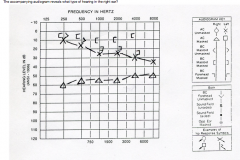
What type of hearing loss is in the right ear? A. Conductive B. Mixed C. Sensorineural D. Normal hearing |
A. Conductive hearing loss |
|
|
When air conduction is impaired and bone conduction is normal, the interpretation is: A. normal hearing B. mixed hearing loss C. sensorineural hearing loss D. conductive hearing loss |
D. Conductive hearing loss |
|
|
Which best describes the scope of practice for SLPs in regards to middle ear testing? A. SLPs can make judgments and provide descriptive statements regarding underlying medical causes of middle ear pathology. B. SLPs may perform diagnostic tympanometry and acoustic reflex threshold testing. C. SLPs may screen for middle ear pathology through tympanometry and an acoustic reflex screen. D. SLPs cannot perform any middle ear measurements under their scope of practice. |
C. SLPs may screen for middle ear pathology through tympanometry and an acoustic reflex screen. |
|
|
A Type B tympanogram may be attributed to any of the following except: A. impacted cerumen B. disarticulated ossicular chain C. otitis media with effusion D. probe tip against canal wall |
B. disarticulated ossicular chain |
|
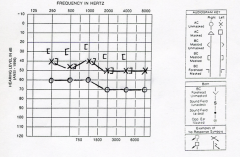
The degree of hearing loss in the left ear is: A. mild B. moderate C. moderately-severe D. severe |
B. moderate |
|
|
An audiogram indicating sensorineural hearing loss will show: A. normal bone conduction and an air-bone gap B. normal air conduction and an air-bone gap C. impaired bone conduction and no air-bone gap D. impaired bone conduction and an air-bone gap |
C. impaired bone conduction and no air-bone gap |
|
|
Pressure-equalizing tubes are designed to function primarily as an artificial: A. ear canal B. eustachian tube C. tympanic membrane D. middle ear |
B. eustachian tube |
|
|
Pure-tone test results showing a mixed type of hearing loss will indicate: A. impaired air conduction and no air-bone gap B. normal bone conduction and an air-bone gap C. impaired bone conduction and an air-bone gap D. impaired bone conduction and no air-bone gap |
C. impaired bone conduction and an air-bone gap |
|
|
The air conduction pathway is the A. inner ear, auditory nerve B. outer ear, middle ear C. outer ear, middle ear, inner ear, auditory nerve D. middle ear, inner ear, auditory nerve |
C. outer ear, middle ear, inner ear, auditory nerve |
|
|
Word recognition tests are routinely performed during audiometric testing for which reason? A. They can be used to verify the pure tone average. B. They are used to determine the uncomfortable loudness level (UCL). C. They are used to determine the extent of any speech detection difficulty. D. They are used to determine the extent of any speech discrimination difficulty. |
D. They are used to determine the extent of any speech discrimination difficulty. |
|
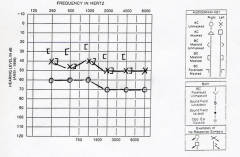
What type of hearing is present in the left ear? A. normal hearing B. conductive loss C. sensorineural loss D. mixed loss |
C. sensorineural loss |
|
|
Given a 45 dB conductive hearing loss in the right ear and normal hearing in the left ear, otoacoustic emissions are expected to be: A. absent in both ears B. present in both ears C. present in the left ear, absent in the right ear D. present in the right ear, absent in the left ear |
C. present in the left ear, absent in the right ear |
|
|
The parts of the auditory system that are most susceptible to damage from hazardous noise levels are: A. tympanic membranes B. middle ear ossicles C. hair cells in the cochlea D. auditory cortex |
C. hair cells in the cochlea |
|
|
A person with a moderate degree of hearing loss A. will miss soft speech only B. will miss a majority of normal level speech C. may not hear voices at all, unless speech is extremely loud D. may only detect sound as vibrations |
B. will miss a majority of normal level speech |
|
|
Performing routine visual inspection and listening checks for clients' hearing devices falls under the scope of practice of: A. speech pathologists B. audiologists C. neither of these professions D. both of these professions |
D. both of these professions |
|
|
The main objective for providing a listening device to an individual with hearing loss is: A. To make speech audible, without introducing distortion or discomfort B. To restore a range of loudness C. Both a and b D. Neither a nor b |
C. both a and b |
|
|
The receiver of a hearing aid: A. acts as a miniature loudspeaker and delivers sound to the tympanic membrane B. receives signals from the environment C. includes a preamplifier stage D. is also known as a microphone |
A. acts as a miniature loudspeaker and delivers sound to the tympanic membrane |
|
|
The component of a cochlear implant that filters, analyzes, and digitizes the sound into coded signals is called A. the speech processor B. the electrode array C. the receiver D. the transmitter |
A. the speech processor |
|
|
An advantage of binaural amplification (hearing aids in both ears) is: A. the enhancement of low-frequency sound reception B. reduction of background noise C. the decrease of signal-to-noise ratios D. elimination of head shadow |
B. reduction of background noise |
|
|
What factor(s) contribute(s) to the variability of speech perception abilities in adults and children who have received a cochlear implant? A. age at implantation B. audiologist experience C. length of profound deafness D. a and b E. a and c |
E. a and c |
|
|
A patient has the following pure tone thresholds in her left ear: 500 Hz - 20 dB HL 1000 Hz - 35 dB HL 2000 Hz - 45 dB HL It is predicted that her Speech Reception Threshold will be closest to: A. 20, B. 45, C. 35, D. 25 |
C. 35 |
|
|
Word recognition tests are routinely performed during audiometric testing for which reason? A. they can be used to verify the pure tone average B. they are used to determine the uncomfortable loudness level (UCL) C. they are used to determine the extent of any speech detection difficulty D. they are used to determine the extent of any speech discrimination difficulty |
D. they are used to determine the extent of any speech discrimination difficulty |
|
|
When air conduction is impaired and bone conduction is normal, the interpretation is: A. normal hearing B. mixed loss C. sensorineural loss D. conductive loss |
D. conductive loss |
|
|
Pure tone test results showing a mixed type of hearing loss will indicate: A. impaired air conduction and no air-bone gap B. normal bone conduction and an air-bone gap C. impaired bone conduction and an air-bone gap D. impaired bone conduction and no air-bone gap |
C. impaired bone conduction and an air-bone gap |
|
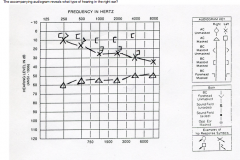
What type of hearing is in the right ear? A. conductive loss B. mixed loss C. normal hearing D. sensorineural loss |
A. conductive loss |
|
|
At the beginning of a pure tone hearing screening, if a patient does not respond to the 40 dB cue tone, the tester should: A. raise the level of the tone to 60 dB B. raise the level of the tone to 80 dB C. proceed on with screening at 20 dB D. abort the test |
A. raise the level of the tone to 60 dB |
|
|
An audiogram indicating a sensorineural hearing loss will show: A. normal bone conduction and an air-bone gap B. normal air conduction and an air-bone gap C. impaired bone conduction and no air-bone gap D. impaired bone conduction and an air-bone gap |
C. impaired bone conduction and no air-bone gap |
|
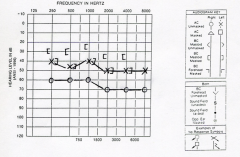
What type of hearing is in the left ear? A. normal hearing B. conductive loss C. sensorineural loss D. mixed loss |
C. sensorineural loss |
|
|
Patients who fail an initial pure tone screening, but pass an initial tympanometry screening A. should be rescreened in 2 to 4 weeks B. should see an audiologist for a full audiologic evaluation C. have passed the audiologic screening D. should see a physician for a medical eval. |
A. should be rescreened in 2 to 4 weeks |
|
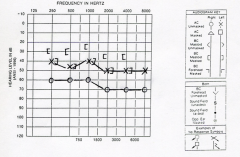
The degree of hearing loss in the left ear is essentially? A. mild B. moderate C. moderately-severe D. severe |
B. moderate |
|
|
Biologic listening checks of a portable audiometer should be performed: A. once a month B. once a week C. once a year D. before each screening session |
D. before each screening session |
|
|
The main objective for providing a hearing aid to an individual with hearing loss is: A. to make speech audible, without introducing distortion or discomfort B. to restore a range of loudness C. both a and b D. neither a nor b |
C. both a and b |
|
|
Which hearing aid feature helps to make speech understanding in background noise easier? A. directional microphones B. digital noise reduction C. telecoil, when used with an ALD D. all of the above |
D. all of the above |
|
|
The advantages of binaural hearing aids for bilateral hearing loss include all of the following except: A. easier maintenance B. elimination of head shadow C. loudness summation D. binaural squelch |
A. easier maintenance |
|
|
Stimulation through the electrode array allows the cochlear implant system to bypass which damaged part of the auditory system? A. pinna B. auditory nerve C. hair cells D. auditory cortex |
C. hair cells |
|
|
For an adult patient to audiologically qualify for a cochlear implant, their word recognition scores must be less than ______ in the ear to be implanted. A. 20% B. 40% C. 50% D. 60% |
C. 50% |
|
|
An 8 month old baby had her hearing tested for the first time 2 weeks ago. Her audiologist determined that she had a bilateral profound sensorineural hearing loss. Her parents will like her to use audition and oral language. The audiologist would recommend: A. The baby should be scheduled for cochlear implant surgery B. The baby should be fitted with an ITE aid C. She should undergo a trial period with a hearing aid for 3 months and then be considered for CI candidacy D. She be fitted with amplification and then evaluated at age 2 years for CI implamentation |
C. She should undergo a trial period with a hearing aid for 3 months and then be considered for CI candidacy |
|
|
The component of a cochlear implant that receives the acoustic signal from the environment is called: A. the microphone B. the speech processor C. the receiver D. the electrode array |
A. the microphone |
|
|
FM systems can help to ease speech understanding in noise by A. eliminating background noise B. increasing the signal-to-noise ratio D. eliminating the need for hearing aids |
B. increasing the signal-to-noise ratio |
|
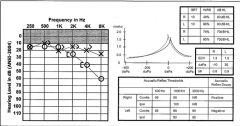
Middle ear function is normal in the left ear? A. True B. False |
A. True |
|
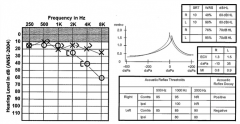
There is a sensorineural hearing loss in the right ear? A. True B. False |
A. True |
|

The degree of hearing loss in the right ear is normal sloping to moderate. A. True B. False |
B. False |
|
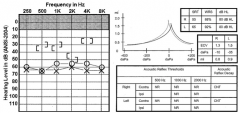
There is a sensorineural hearing loss in both ears. A. True B. False |
B. False |
|
|
Which of the following does not fall under the scope of practice for a SLP working with a school age child with hearing loss? A. Asses their perception and production of speech characteristics B. Share information with teachers concerning the child's communication skills in comparison to normal-hearing peers C. Evaluate amplification devices used in the classroom D. Adjust a student's hearing aid settings when they appear to be inadequate for hearing speech. |
D. Adjust a student's hearing aid settings when they appear to be inadequate for hearing speech |
|
|
A patient has a completely occluding cerumen plug in their ear canal. What might we expect regarding their hearing in that ear? A. normal hearing B. a temporary conductive hearing loss C. a temporary sensorineural hearing loss d. a temporary mixed hearing loss |
B. a temporary conductive hearing loss |
|
|
The air-conduction pathway is the: A. inner ear, auditory nerve, and beyond B. outer ear, middle ear C. outer ear, middle ear, inner ear, auditory nerve, and beyond D. middle ear, inner ear, auditory nerve, and beyond |
C. outer ear, middle ear, inner ear, auditory nerve, and beyond |
|
|
Bone conduction thresholds can theoretically be worse than air conduction thresholds A. True B. False |
B. False |
|
|
The Hughson-Westlake procedure is also known as the "Down 5-Up 10" procedure A. True B. False |
B. False |
|
|
The Speech Recognition Threshold is the lowest hearing level at which speech can barely be understood A. True B. False |
A. True |
|
|
The average intensity of conversational speech equates to approximately _____ dB on the audiogram. A. 25 dB HL B. 45 dB HL C. 65 dB HL D. 85 dB HL |
B. 45 dB HL |
|
|
A person with untreated mild degree of hearing loss will likely experience which of the following? A. Will miss some soft speech, such as consonants B. Will miss almost all soft speech C. Will miss approximately 50-75% of normal level speech D. Will miss approximately 80-100% of normal level speech |
B. Will miss almost all soft speech |
|
|
In a cochlear implant system, the speech processor filters, analyzes, and digitizes the sound into coded systems. A. True B. False |
A. True |
|
|
Which of the following is not likely to contribute to speech and language acquisition success in pediatric cochlear implant users. A. age at implementation B. Duration of deafness C. Greater residual hearing prior to implementation D. use of an infrared ALD prior to implementation |
D. use of an infrared ALD prior to implementation |
|
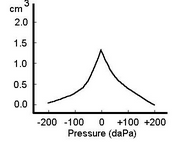
This tympanogram may be seen in all of the following except: A. normal hearing B. mild sensorineural hearing loss C. severe sensorineural hearing loss D. middle ear fluid and infection |
D. middle ear fluid and infection |
|
|
Given a 45 dB conductive hearing loss in the right ear and normal hearing in the left ear, otoacoustic emissions are expected to be: A. absent in both ears B. present in both ears C. present in the left ear, absent in the right ear D. present in the right ear, absent in the left ear |
C. present in the left ear, absent in the right ear |
|
|
A Type B tympanogram may be attributed to any of the following except: A. impacted cerumen B. disarticulated ossicular chain C. otitis media D. tympanometer probe tip against canal wall |
B. disarticulated ossicular chain |
|
|
A tympanogram with maximum compliance at -200 daPa suggests A. positive pressure in the middle ear B. normally aerated middle ear C. fluid in the middle ear D. negative pressure in the middle ear |
D. negative pressure in the middle ear |
|
|
Which of the following statements best describes the scope of practice for SLPs in regards to middle ear testing A. SLPs can make judgments and provide descriptive statements regarding underlying medical causes of middle ear pathology B. SLPs may perform diagnostic tympanometry and acoustic reflex threshold testing C. SLPs may screen for middle ear pathology through tympanometry D. SLPs cannot perform any middle ear measurements under their scope of practice |
C. SLPs may screen for middle ear pathology through tympanometry |
|
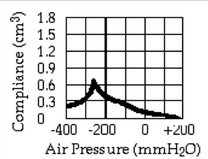
Under the Jerger Classification System, this tympanogram is classified as which type? A. Type A B. Type B C. Type C |
C. Type C |
|

Under the Jerger Classification System, this tympanogram is classified as which type? A. Type A B. Type B C. Type C |
B. Type B |
|
|
Your results of a tymp screening show a type B tymp with an ear canal volume of 3.7 cm3 (an exceptionally large volume), might indicate that the: A. ear drum and middle ear space are normal B. there is excessive cerumen in the ear canal C. there is likely fluid in the middle ear space D. there is likely a perforation in the tympanic membrane |
D. there is likely a perforation in the tympanic membrane |
|
|
An otoacoustic emission is robust when it is _____ dB or more above the noise floor level. A. 3 B. 6 C. 8 D. 10 |
B. 6 |
|
|
A type As tympanogram, with all other tests coming in at normal levels, indicates a need for referral to a medical professional A. True B. False |
B. False |
|
|
If you are doing a hearing screening on a young child or a difficult to test patient, and they are unable to participate in a regular pure-tone hearing screening, an OAE screening may be used instead A. True B. False |
A. true
|
|
|
When an OAE response is not seen, it usually suggests that hearing loss is present, but does not reveal whether the problem is in the conductive pathway or the cochlea. A. true B. false |
A. true |
|
|
If an OAE screening results in a "pass" result, it may be inferred that the pathway up to the auditory cortex is unimpaired. A. true B. false |
B. false |
|
|
The cone of light appears on what part of the tympanic membrane? A. inferior-anterior B. superior-posterior C. superior-anterior D. inferior-posterior |
A. inferior-anterior |
|
|
Cerumen is produced in the A. osseous external auditory canal B. entire external auditory canal C. temporomandibular joint D. cartilaginous external auditory canal |
D. cartilaginous external auditory canal |
|
|
Pressure-equalizing tubes (ear tubes) are designed to function primarily as an artificial A. ear canal B. eustachian tube C. tympanic membrane D. middle ear |
B. eustachian tube |
|
|
Which auditory structure is responsible for transmitting incoming signals from the cochlea to the higher central auditory nervous system structures through frequency tuned fibers? A. Cochlear nucleus B. Auditory nerve C. Superior olivary complex D. Thalamus |
B. Auditory nerve |
|
|
Auditory dysfunction below the level of the ____ will result primarily in same-side (ipsilateral) abnormalities, whereas dysfunction at or above this level will result in bilateral or contralateral abnormalities A. cochlear nucleus B. superior olivary complex C. inferior colliculus D. thalamus |
A. cochlear nucleus |
|
|
The Eustachian tube does all of the following except: A. allow oxygen into the middle ear B. equalize air pressure C. funnel sound to the middle ear D. drain fluid from the middle ear |
C. funnel sound to the middle ear |
|
|
The frequency response pattern of the sensory cells in the cochlea goes from the lowest frequencies in the basal end of the cochlea to the highest frequencies in the apical end. A. True B. False |
B. False |
|
|
(C)APD is an auditory deficit that is not caused by other higher-order cognitive, language, or related disorders A. true B. false |
A. True |
|
|
(C)APD may not coexist with difficulties in higher order language, learning, and communication functions A. true B. false |
B. false |
|
|
Although the terms language processing and auditory processing sometimes are used interchangeably, it is critical to understand that they are not the same thing. A. true B. false |
A. true |
|
|
Which of the following is commonly exhibited by children with (C)APD? A. Difficulty understanding speech in noisy environments B. Difficulty following directions C. Difficulty telling the difference between similar-sounding speech sounds D. All of the above |
D. all of the above |
|
|
(C)APD can be diagnosed based on how many symptoms and/or characteristics a child exhibits on a checklist. A. true B. false |
B. false |
|
|
Which member(S) of the multidisciplinary team can diagnose (C)APD? A. SLP B. psychologist C. audiologist D. all of the above |
c. audiologist |
|
|
(C)APD screening can be conducted by which multidisciplinary team member(s) A. SLP B. psychologist C. audiologist D. all of the above |
D. all of the above |
|
|
At this time, there is no universally accepted method of screening for (C)APD. A.True B. False |
A. True |
|
|
Consistent with the ASHA Scope of Practice in SLP statement, the SLP has a role in the differential diagnosis of language processing disorders from (C)APD. A. true B. false |
A. True |
|
|
(C)APD test results can be questionable when gathered from a child under what age? A. 4 B. 5 C. 7 D. There is no age limit to testing for (C)APD |
C. 7 |
|
|
Diagnosis of (C)APD generally requires performance deficits on the order of at least two standard deviations below the mean on at least one test in the battery. A. True B. False |
B. False |
|
|
Classification systems, or models, that categorize patients based on their test results are universally accepted and must serve as useful guides in the interpretation of central auditory test results and development of deficit-focused intervention plans A. True B. False |
B. False |
|
|
In addition to the language and academic difficulties often associated with (C)APD have a higher likelihood of behavioral, emotional, and social difficulties A. True B. False |
A. True |
|
|
When considering environmental or communication environment modifications to treat (C)APD, which of the following is a reasonable recommendation? A. Use of an FM system B. Encouraging the speaker to speak at a normal rate so that the listener can strengthen their listening abilities C. Removing visual aids so that the individual can strengthen their listening ability D. Maintaining the normal acoustic properties of a classroom, even though there may be competing noise, so that the individual can strengthen their listening skills |
A. Use of a FM system |
|
|
When treating (C)APD, compensatory strategies usually consist of suggestions for assisting listeners in strengthening central resources (language, problem-solving, memory, attention, other cognitive skills) so that they can be used to help overcome the auditory disorder. A. true B. false |
A. true |
|
|
There are many types of auditory processing deficits in (C)APD, therefore it is necessary to determine the type of auditory deficit a given child exhibits A. true B. false |
A. true |
|
|
There is one general approach to treating (C)APD, therefore all children who are given the diagnosis should be treated in the same general manner. A. true B. false |
B. false |
|
|
Which is an area of debate surrounding a diagnosis of (C)APD? A. the term auditory processing is often used loosely by individuals in many different settings to mean many different things, and the label (C)APD has been applied (often incorrectly) to a wide variety of disorders B. there are some who assume the term (C)APD is applicable to any child or adult who has difficulty listening or understanding spoken language C. Some definitions of (C)APD imply or state outright that the diagnosis of (C)APD can be applied only when a perceptual deficit is demonstrated in the auditory system and no where else D. all of the above |
D. all of the above |

